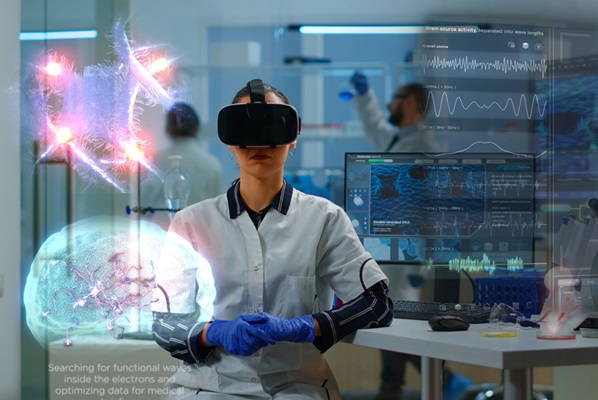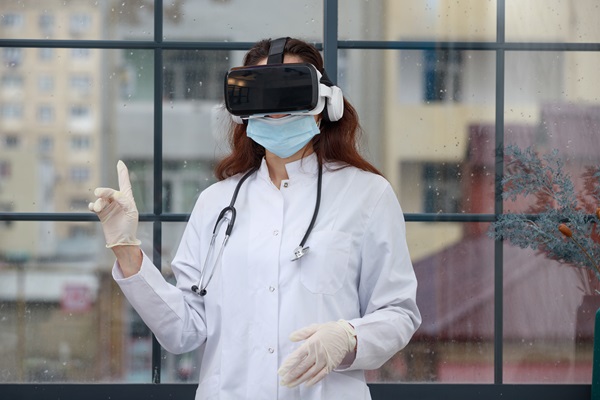Technology for healthcare is fundamentally changing the way patient care is delivered, improving outcomes, and making healthcare more accessible. From artificial intelligence (AI) and telemedicine to wearable devices and 3D printing, healthcare technology is at the forefront of modern medicine, enhancing diagnostics, treatment, and overall patient well-being. These innovations have rapidly accelerated the shift toward a more personalized, efficient, and data-driven healthcare system.

I. Introduction
The role of technology in healthcare is multifaceted. It spans various aspects of care delivery, such as early diagnosis, patient monitoring, treatment customization, and surgical procedures. As technology evolves, it continues to disrupt traditional healthcare models, offering new avenues for providers to improve patient outcomes. This article will delve into the key technological advancements driving change in patient care, highlighting how these innovations are revolutionizing healthcare and addressing some of the industry’s most pressing challenges.
II. Telemedicine and Virtual Healthcare
A. The Rise of Telemedicine: Expanding Access to Care
Telemedicine, a groundbreaking development in technology for healthcare, has transformed how care is provided, particularly for patients in remote or underserved areas. With the growing prevalence of smartphones, broadband internet, and video conferencing technologies, telemedicine has made it possible for patients to receive medical consultations, diagnoses, and treatments from the comfort of their homes.
The rise of telemedicine during the COVID-19 pandemic marked a turning point in virtual healthcare adoption, as both patients and healthcare providers sought safe alternatives to in-person visits. Telemedicine enables timely care, particularly for patients with chronic conditions, mental health concerns, or mobility issues, who may struggle to attend regular in-person appointments.
B. Benefits of Virtual Health Services for Patients and Providers
The benefits of telemedicine, a key component of technology for healthcare, extend to both patients and providers. Patients enjoy greater convenience, reduced travel times, and quicker access to medical professionals, while healthcare providers can reach more patients and reduce the strain on physical facilities. Moreover, telemedicine can reduce costs for healthcare systems by decreasing emergency room visits and hospital readmissions.
Virtual healthcare services have also improved care continuity by enabling providers to offer follow-up care and consultations without the logistical challenges of scheduling in-person visits. This increased accessibility and convenience are critical to improving patient satisfaction and outcomes.
C. Case Studies: Success Stories in Telemedicine Adoption
Numerous success stories have emerged with the adoption of telemedicine as part of technology for healthcare. For example, Cleveland Clinic expanded its telemedicine services during the pandemic, seeing a 1,000% increase in virtual visits. Similarly, Kaiser Permanente’s telemedicine platform allowed for nearly 80% of all visits to be conducted virtually in 2020, providing continuity of care even during lockdowns. These examples highlight how technology for healthcare is facilitating better access to care, especially in times of crisis.
III. AI and Machine Learning in Diagnostics
A. Enhancing Accuracy in Medical Diagnoses with AI
AI has become an indispensable tool in modern healthcare diagnostics, helping healthcare providers analyze large amounts of data with greater speed and accuracy than ever before. AI algorithms can identify patterns and anomalies in medical images, lab results, and patient records, leading to more accurate and earlier diagnoses. AI technology for healthcare is being used in fields such as radiology, pathology, and oncology to detect diseases like cancer at earlier stages, improving patient outcomes.
B. AI-powered Predictive Analytics and Personalized Care
AI-powered predictive analytics, another innovation in technology for healthcare, allows physicians to anticipate patient needs and health outcomes based on historical data. This is especially useful for chronic disease management, where AI can predict disease progression and suggest personalized treatment plans.
AI is also advancing personalized care by analyzing genetic data to create individualized treatment protocols. For example, AI is used in pharmacogenomics to determine how patients might respond to specific drugs, reducing trial-and-error in medication management and improving efficacy.
C. Real-world Examples of AI-driven Diagnostic Tools
One notable example of AI technology for healthcare is IBM’s Watson Health, which uses AI to assist in medical research and cancer diagnostics. In radiology, AI tools like Aidoc analyze medical imaging to flag abnormalities, helping radiologists focus on areas that require closer attention. These innovations in AI diagnostics are paving the way for more efficient, accurate, and personalized healthcare.
IV. Wearable Health Technology
A. Overview of Wearable Devices and Their Impact on Preventive Care
Wearable health technology, a growing field within technology for healthcare, is playing an essential role in preventive care and chronic disease management. Devices like fitness trackers, smartwatches, and continuous glucose monitors (CGMs) provide real-time data on a patient’s health, including heart rate, activity levels, sleep patterns, and blood glucose levels.
These devices empower individuals to take control of their health by providing actionable insights into their daily behaviors and overall well-being. Wearable technology for healthcare encourages healthier lifestyles and promotes early intervention, allowing for timely adjustments in treatment or lifestyle before conditions worsen.
B. Continuous Health Monitoring and Data Tracking
Continuous health monitoring through wearable devices enables healthcare providers to track patient data over time, offering a more comprehensive understanding of their health. For instance, patients with cardiovascular issues can use smartwatches equipped with ECG sensors to monitor their heart health, while diabetic patients can use CGMs to track glucose levels continuously.
By providing continuous data tracking, wearable health technology allows for early detection of potential health issues, enabling more proactive and personalized care. This aspect of technology for healthcare is particularly valuable for managing chronic diseases and preventing complications.
C. Case Studies: How Wearable Tech is Improving Patient Outcomes
One example of wearable technology improving patient outcomes is the use of the Apple Watch’s ECG feature to detect atrial fibrillation (AFib), a potentially serious heart condition. Numerous patients have reported early detection of AFib through their Apple Watches, allowing them to seek medical attention before the condition escalates. Similarly, CGMs like Dexcom’s G6 system have revolutionized diabetes management, enabling patients to maintain better glucose control and reduce the risk of complications. These case studies underscore the transformative potential of wearable technology for healthcare.

V. Robotics in Surgery and Patient Care
A. Robotic-Assisted Surgeries: Improving Precision and Outcomes
Robotics is another cutting-edge area of technology for healthcare, particularly in the field of surgery. Robotic-assisted surgeries, such as those performed with the da Vinci Surgical System, offer unparalleled precision, reducing the risk of complications and improving patient recovery times. These systems allow surgeons to perform complex procedures with enhanced control and accuracy, resulting in less invasive surgeries and better patient outcomes.
B. The Use of AI in Rehabilitation and Elderly Care
Robots are also being used in rehabilitation and elderly care, another critical area of technology for healthcare. AI-powered robots like the RIBA (Robot for Interactive Body Assistance) assist in lifting and moving patients, reducing the physical strain on caregivers. In rehabilitation, robotic exoskeletons help patients with mobility impairments regain movement and strength through controlled exercise routines.
C. Examples of Robotic Innovations in Healthcare
In addition to surgical robots, innovations like robotic prosthetics and telepresence robots are making strides in healthcare. Robotic prosthetics, equipped with advanced sensors and AI, offer greater mobility and functionality to amputees. Telepresence robots, which allow physicians to remotely monitor and communicate with patients, are enhancing care delivery in hospitals and home care settings. These advances demonstrate the growing role of robotics in technology for healthcare.
VI. Electronic Health Records (EHR) and Interoperability
A. Streamlining Healthcare with Digital Health Records
Electronic Health Records (EHRs) are a vital aspect of technology for healthcare, streamlining the storage, sharing, and management of patient information. EHRs replace cumbersome paper records with digital files, making it easier for healthcare providers to access, update, and share patient information securely and efficiently.
B. Improving Communication Across Healthcare Systems
Interoperability, the ability of different healthcare systems to communicate and exchange data, is a key challenge being addressed by technology for healthcare. Interoperability ensures that patient information flows seamlessly between healthcare providers, reducing errors and improving care coordination.
C. Benefits of EHR for Patient Safety and Care Continuity
EHRs improve patient safety by ensuring that providers have access to a patient’s complete medical history, reducing the risk of medication errors and redundant testing. Additionally, EHRs support care continuity by allowing different providers to collaborate more effectively, ensuring that patients receive consistent care across various settings.
VII. 3D Printing in Medical Applications
A. Revolutionizing Prosthetics and Implants with 3D Printing
3D printing is a revolutionary technology for healthcare, particularly in the creation of custom prosthetics and implants. 3D-printed prosthetics offer greater customization, allowing for better fit and function compared to traditional methods. Similarly, 3D printing is used to create personalized implants, such as dental implants or joint replacements, tailored to a patient’s specific anatomy.
B. Personalized Medical Solutions: From Organs to Surgical Tools
Beyond prosthetics and implants, 3D printing technology for healthcare is being used to create personalized medical solutions, including surgical tools and even bio-printed tissues. Researchers are exploring the possibility of printing organs, such as livers and kidneys, for transplant patients, which could eventually address the shortage of donor organs.
C. Case Studies: Successful Applications of 3D Printing in Healthcare
One notable case study is the successful use of 3D printing to create patient-specific surgical models, which help surgeons plan and practice complex procedures before performing them on patients. For example, 3D-printed heart models have been used in pediatric cardiology to improve surgical outcomes. These applications of 3D printing highlight the potential of technology for healthcare to revolutionize patient care.
VIII. Genomics and Precision Medicine
A. Genetic Profiling for Targeted Therapies
Genomics is at the forefront of precision medicine, an emerging field of technology for healthcare that tailors treatment to a patient’s genetic makeup. Genetic profiling allows physicians to identify specific mutations or biomarkers associated with diseases like cancer, enabling the development of targeted therapies that are more effective and less toxic than traditional treatments.
B. Precision Medicine: Tailoring Treatment to Individual Patients
Precision medicine, a rapidly growing area of technology for healthcare, focuses on customizing treatments based on an individual’s unique genetic, environmental, and lifestyle factors. This approach is transforming the treatment of diseases like cancer, where targeted therapies have led to significant improvements in survival rates and quality of life for patients.
C. Innovations in Genomics Leading to Breakthrough Treatments
Recent innovations in genomics, such as CRISPR gene-editing technology, are leading to breakthrough treatments for genetic disorders, cancers, and other diseases. CRISPR allows scientists to precisely edit DNA, potentially curing genetic diseases at their source. These advancements in genomics highlight the transformative potential of technology for healthcare.

IX. Blockchain in Healthcare
A. Ensuring Data Security and Privacy with Blockchain
Blockchain technology for healthcare offers a new level of data security and privacy, addressing concerns about the confidentiality of patient records. Blockchain’s decentralized and encrypted nature makes it highly secure, protecting sensitive patient information from breaches and unauthorized access.
B. Streamlining Healthcare Transactions and Record-Keeping
Blockchain also has the potential to streamline healthcare transactions and record keeping, reducing administrative burdens and improving efficiency. For example, blockchain can be used to verify insurance claims, track medical supplies, and manage consent for data sharing, all while ensuring data integrity.
C. Future Potential of Blockchain for Improving Healthcare Efficiency
The future potential of blockchain technology for healthcare is vast. As the technology matures, it could revolutionize areas like patient data management, clinical trials, and supply chain transparency, ultimately improving healthcare efficiency and reducing costs.
X. Challenges and Ethical Considerations
A. Privacy Concerns with Technology in Healthcare
While technology for healthcare offers many benefits, it also raises concerns about data privacy. As more patient information is digitized, the risk of data breaches increases, making it essential to implement robust security measures.
B. Regulatory Hurdles in Implementing New Technologies
Another challenge in adopting new healthcare technologies is navigating the regulatory landscape. Governments and healthcare institutions must balance the need for innovation with ensuring patient safety and privacy.
C. Balancing Technology with Human-Centered Care
As technology continues to play a larger role in healthcare, it’s important to maintain a balance between technological advancements and human-centered care. Healthcare providers must ensure that technology enhances, rather than replaces, the personal connection between patients and caregivers.
XI. Future Trends in Healthcare Technology
A. The Role of AI in Predictive Healthcare and Early Detection
The future of technology for healthcare will likely be dominated by AI, particularly in predictive healthcare and early detection of diseases. AI algorithms could soon be used to predict disease outbreaks, detect early signs of diseases like Alzheimer’s, and recommend preventive measures.
B. Nanotechnology and Its Potential in Future Treatments
Nanotechnology is another emerging field in technology for healthcare, offering potential breakthroughs in drug delivery, cancer treatment, and regenerative medicine. Nanoparticles can be designed to target specific cells, improving treatment precision and reducing side effects.
C. Anticipated Innovations Shaping the Future of Patient Care
Other anticipated innovations in healthcare technology include the development of smart implants, advanced robotic prosthetics, and brain-computer interfaces. These technologies have the potential to significantly enhance patient care, offering new treatment options for previously untreatable conditions.
XII. Conclusion
In conclusion, technology for healthcare is revolutionizing the medical field, improving patient outcomes, and transforming the way care is delivered. From AI-powered diagnostics and wearable devices to telemedicine and 3D printing, these innovations are making healthcare more accessible, personalized, and efficient.
As healthcare technology continues to evolve, it will play an increasingly critical role in enhancing patient care and addressing global healthcare challenges. The future of healthcare is bright, with ongoing advancements in AI, genomics, robotics, and other fields promising to reshape the industry. Embracing these technologies will be essential for healthcare providers, policymakers, and patients alike as we move toward a more efficient and patient-centered healthcare system.
Technology for healthcare is not just a trend; it’s a fundamental shift that is here to stay. With the right approach and continued innovation, technology will continue to revolutionize healthcare, making it more effective, efficient, and accessible for all.

